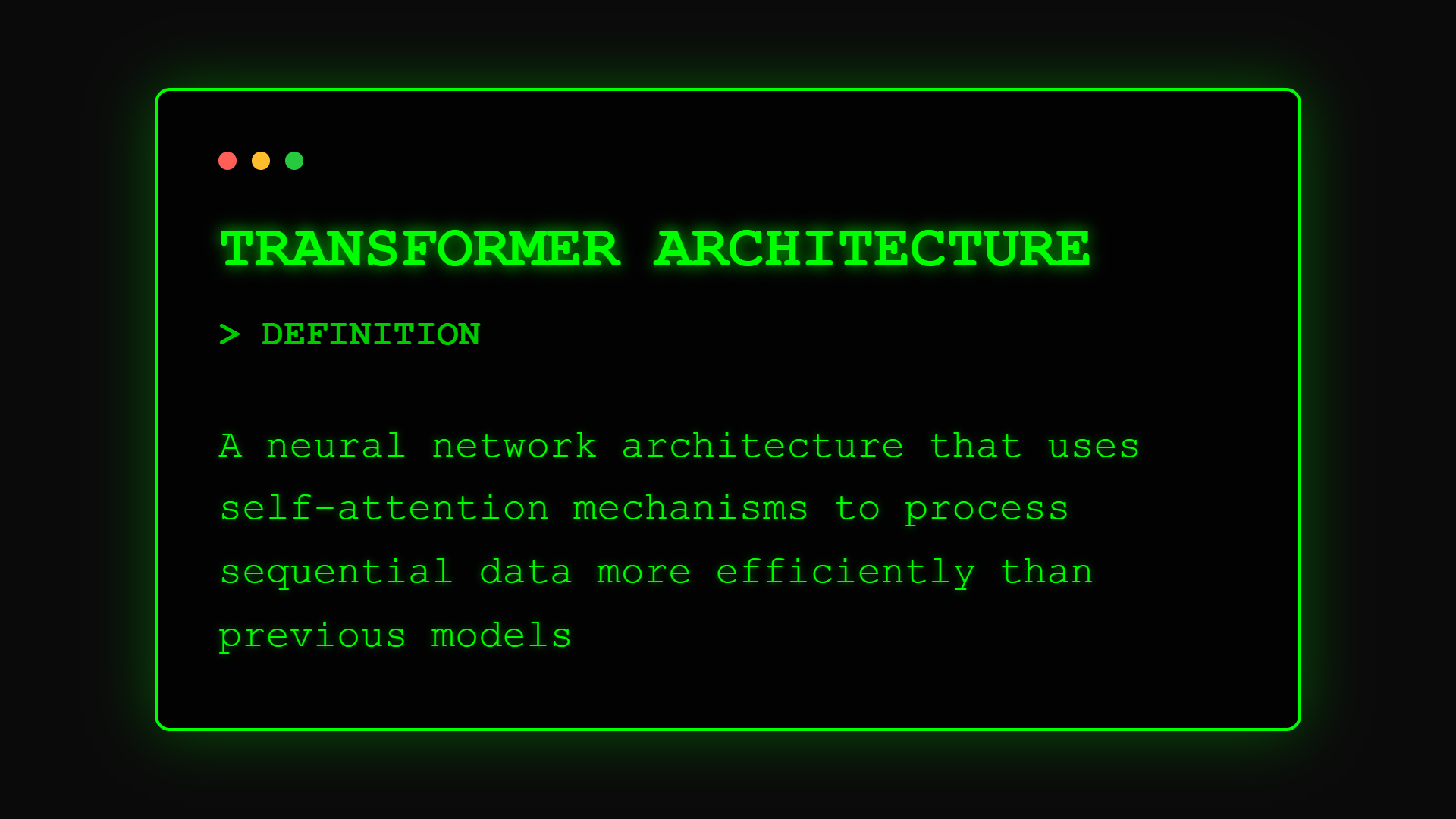AI Terms
What is Transformer Architecture? The Blueprint That Changed AI Forever

Before 2017, AI struggled with long documents and lost context quickly. Then came Transformers – the architecture behind ChatGPT, BERT, and virtually every breakthrough in modern AI. Understanding this innovation helps you grasp why today's AI is so powerful and what's possible for your business.
Technical Breakthrough
The Transformer is a neural network architecture introduced in the landmark paper "Attention Is All You Need" (2017) by Google researchers. It revolutionized AI by processing entire sequences simultaneously rather than word-by-word, using a mechanism called self-attention to understand relationships between all parts of the input.
According to the original paper, "Transformers dispense with recurrence and convolutions entirely, relying solely on attention mechanisms to draw global dependencies between input and output." This parallel processing made training 100x faster while improving quality.
The architecture's efficiency and effectiveness led to the AI renaissance we're experiencing, enabling models with billions of parameters that understand context like never before.
Business Impact
For business leaders, Transformer architecture is why modern AI can read entire contracts, maintain context in long conversations, and generate coherent reports – it's the engineering breakthrough that made AI truly useful for complex business tasks.
Think of earlier AI like someone reading a book through a keyhole, seeing one word at a time and forgetting earlier parts. Transformers are like reading the entire page at once, understanding how every word relates to every other word instantly.
In practical terms, Transformers enable customer service bots that remember the whole conversation, document analysis that understands complex relationships, and content generation that maintains consistency across pages.
Core Components
Transformers consist of key innovations:
• Self-Attention Mechanism: Allows every word to "attend" to every other word, understanding relationships like pronouns referring to earlier nouns
• Positional Encoding: Adds information about word order since Transformers process all words simultaneously, not sequentially
• Multi-Head Attention: Multiple attention mechanisms running in parallel, each learning different types of relationships
• Feed-Forward Networks: Process the attended information to extract meaning and generate outputs
• Layer Stacking: Multiple transformer blocks stacked deep, each refining understanding progressively
How Transformers Work
The Transformer process simplified:
Input Encoding: Text converted to embeddings with position information added to preserve sequence order
Self-Attention Calculation: Every token computes its relationship to every other token, creating attention weights
Context Integration: Attention weights combine information from relevant parts of the input for each position
Layer Processing: Multiple layers refine understanding, with each layer building on previous insights
Output Generation: Final representations used for tasks like classification, translation, or text generation
This parallel processing is why Transformers train faster and scale better than previous architectures.
Transformer Variants
Different designs for different needs:
BERT (Bidirectional) Focus: Understanding context from both directions Best for: Search, classification, question answering Example: Google Search understanding
GPT (Autoregressive) Focus: Generating text left-to-right Best for: Content creation, conversation Example: ChatGPT, writing assistants
T5 (Text-to-Text) Focus: Framing all tasks as text generation Best for: Versatile applications Example: Translation, summarization
Vision Transformer (ViT) Focus: Applying transformers to images Best for: Computer vision tasks Example: Image classification, medical imaging
Business Applications
Transformers powering solutions:
Legal Tech Example: Law firms use BERT-based systems to analyze contracts, finding relevant clauses across 100-page documents in seconds, understanding context that keyword search would miss, reducing review time by 90%.
Healthcare Example: Google's Med-PaLM 2 (Transformer-based) achieved expert-level medical exam performance by understanding complex medical contexts, enabling AI assistance for diagnosis and treatment planning.
Finance Example: JPMorgan's DocAI uses Transformers to process millions of financial documents, understanding context across pages to extract insights that drive trading decisions and risk assessment.
Why Transformers Dominate
Key advantages driving adoption:
Parallelization:
- Process entire sequences simultaneously
- 100x faster training than RNNs
- Scales efficiently with hardware
Long-Range Dependencies:
- Maintains context over thousands of tokens
- Understands document-level relationships
- Handles complex reasoning tasks
Transfer Learning:
- Pre-train once, fine-tune for many tasks
- Reduces data requirements dramatically
- Enables rapid deployment
Versatility:
- Works for text, images, audio, code
- Same architecture, different applications
- Unified approach to AI
Transformer Limitations
Understanding constraints:
• Computational Cost: Attention scales quadratically with sequence length → Solution: Efficient attention variants
• Context Windows: Still limited to thousands of tokens → Solution: Hierarchical processing, retrieval augmentation
• Data Hunger: Requires massive pre-training datasets → Solution: Few-shot learning, efficient fine-tuning
• Interpretability: Complex attention patterns hard to explain → Solution: Attention visualization tools
Future Directions
Where Transformers are heading:
- Longer context windows (1M+ tokens)
- More efficient attention mechanisms
- Multimodal understanding
- Edge device deployment
- Biological sequence modeling
Leveraging Transformers
Your path to Transformer-powered AI:
- Understand Attention Mechanism at the core
- Explore Large Language Models built on Transformers
- Learn about Fine-tuning for your use cases
- Read our Transformer Applications Guide
FAQ Section
Frequently Asked Questions about Transformer Architecture
Part of the [AI Terms Collection]. Last updated: 2025-01-11